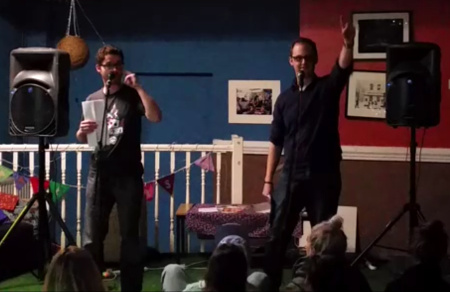What Future for Charities who Invested in Icesave?
Article published: Sunday, August 9th 2009
When banks started to go belly-up the government moved fast to shore up the gaps. But for charities and public bodies who lost millions in the Icesave crash, the future is still uncertain.
 Despite the government guaranteeing their savings, hundreds of thousands of people still queued outside the troubled Northern Rock Bank eager to withdraw their money. Confidence in markets is what keeps banks afloat. Any whiff of panic in the banking sector and billions of pounds might head out of the high street branch and under our mattresses. To avoid the doomsday scenario where the banks actually run out of money, the UK government has bailed them out and borrowed heavily in the process – some loans will take 40 years to repay.
Despite the government guaranteeing their savings, hundreds of thousands of people still queued outside the troubled Northern Rock Bank eager to withdraw their money. Confidence in markets is what keeps banks afloat. Any whiff of panic in the banking sector and billions of pounds might head out of the high street branch and under our mattresses. To avoid the doomsday scenario where the banks actually run out of money, the UK government has bailed them out and borrowed heavily in the process – some loans will take 40 years to repay.
An entire year’s government expenditure has been used to support the banks and their investors. But not everyone has been lucky enough to receive a bail out. Some charities stand to lose millions – especially those that invested in Kaupthing Bank and the British trading arm of Icelandic bank Lansbanki – Icesave.
Although Icesave had been raising a lot of money through the murkier world of ‘securitisation’ it had not forgotten the more traditional approach to banking – borrow at 5 percent and lend at 10. To boost their business Icesave bosses were willing to borrow at 7 percent and lend at 8 percent – a tiny margin which offered the best rate of return for savers in the market. 300,000 UK savers flocked and invested billions. At the point of collapse, in October 2008, the Icelandic banking system owed foreign investors more than £160bn – seven times the country’s gross national product.
When Iceland said it couldn’t afford to repay British investors, the government used anti-terrorist legislation and seized Icelandic assets which were then used to provide security for an initial loan from the treasury of £200m. A further advance of £2.1bn has just been announced by the Treasury. Even in cases when the UK compensation scheme would cover investors, Gordon Brown preferred to heap the blame on the beleaguered Scandinavian island instead. The £2.3bn loan will take Iceland 15 years to repay although UK plc has promised to be ‘flexible’ about how much is paid and when.
The Icelandic government was forced to use the loan to repay British depositors through the Financial Services Compensation Scheme (FSCS). But not all of them. The scheme is intended to protect individual investors rather than organisations – even if they are charities. Local councils, police and other public bodies are estimated to have invested more than £1bn in Icesave.
Charities in particular have been hard-hit and face losing a total of £120m, including The Cats Protection League (£11m), The Samaritans invested (£1m) and many hospices. But now there is a glimmer of hope.
Lobbying by the Charities Aid Foundation has centred on persuading the government that smaller charities worth under £3.25m are covered by the FSCS. In June another bankrupt Icelandic bank – Kaupthing, Singer and Friedlander – gave back £260,000 to the League of Friends of Brampton and District War Memorial Hospital. Other charities are also seeing the cash trickling back and expect to be reimbursed during the summer. The Treasury Committee’s first report on the banking crisis argues that “on this occasion only” charities should be compensated.
Larger charities, however, might not fare so well. A leaked copy of an Ernst and Young assessment of the Icelandic banks suggests that other investors may only get back 50p in the pound in a process taking up to four years.
When it looked like Halifax Bank of Scotland was going to go belly up, the government stitched up a deal to support a Lloyds TSB takeover – literally overnight. Supporting the bank, its shareholders and high-earning staff is costing every household in the UK more than £10,000.
Charities on the other hand have had to wait almost a year to get their money back. And many may only receive a fraction of their investment. Their demands for repayment are worth a tiny fraction of what the banks have already received. At the same time the government has rewarded well-paid risk takers it has forgotten the hundreds of thousands of people who can no longer rely on the charitable assistance they so desperately need.
Following a mass campaign headed by the Manchester Evening News and supported by more than 100,000 signatories, cancer hospital The Christie has been promised the full return of its £6.5m. However, as this was on the back of popular pressure the decision appears politically motivated; indeed, the reason the payment has been channeled through the NHS rather than the FSCS is to stop a flood of similar reimbursement claims.
In a bitter irony a recession caused by the banking sector’s misbehaviour is now hitting charity donations, which are down by a third. “When a recession happens”, Keith Hickey chief executive of the Charities Finance Directors’ Group says, “it is always the most vulnerable people who get hurt and charities have to pick up the pieces.” Yet in a matter of minutes entire social security budgets are spent in minutes propping up shareholders’ interests. The debt owed by Northern Rock would be enough to pay for 900,000 nurses for a year. The Welfare State is as strong as ever, only these days it provides a safety net for private enterprise rather than public good.
Adrian Davies runs http://www.third-sector.co.uk, a consultancy for the voluntary sector which specialises in supporting credit unions and money advice services.
Comments
No comments found
The comments are closed.



